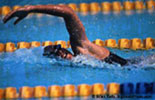|
Sports Medicine - Swimmer's Shoulder |
|
|
The shoulder is often a frequent place of injury for a swimmer. An overuse injury called "swimmer's shoulder" is a common condition which is treated by physical therapists. This injury is often accompanied by pain in the region of the rotator cuff of the shoulder. The pain usually occurs when performing or after performing aspects of swimming which requires repetitive overhead use of the arms. For example, the front crawl often elicits pain in the shoulder for individuals during or after this stroke, while the back stroke can be extremely painful during the stroke. (picture © Brian Kelly. BigStockPhoto.com).
Quite often, for an individual with swimmer’s shoulder, a physical therapist will discover some form of instability and weakness in the shoulder(s) of the swimmer. This instability and weakness could be contributory factors for this injury. A video analysis of the swimmer performing the stroke could also be conducted by the therapist to review the technique and mechanics which are utilized by the swimmer for a given stroke.
Poor stroke techniques and mechanics could result in swimmer’s shoulder or other injuries. Furthermore, weakness in the musculature of the upper & lower back, abdominals, shoulders and shoulder blades will contribute to this as well. Poor technique and mechanics during a certain stroke could lead to abnormal stresses being applied to the structures of the shoulder and could contribute to injury. Weak musculature could make the swimmer more susceptible to poor performance, poor endurance, increase fatigue and an increase likelihood of injury.
Swimming is a dynamic activity which requires all the parts of the body to work together in order to achieve the best possible results. No matter what stroke a swimmer is performing, proper technique and mechanics along with sufficient strength is essential to maximize performance and minimize injury. Having sufficient core strength is required in order to generate power during a stroke while having sufficient arm and leg strength is crucial to maximize propulsion. A deficiency in strength in either area could compromise performance and play a part in injury.
Should an individual have swimmer’s shoulder or another form of an injury, it is recommended that he or she consult with a physician or physical therapist prior to any form of treatment. It is not advised that the individual perform any type of self treatment as this could lead to further complications.
The purpose of this article is to provide additional information for swimmers who are uninjured and would like to know more about how to prevent injuries to the shoulder and other areas of the body. Like any good exercise routine a comprehensive program which includes stretching, strengthening, endurance training, postural training, and functional training is essential for success. Listed below are just a few exercise videos which can be viewed and are prescribed by physical therapists or trainers in order to help swimmers minimize injury and maximize performance. Please remember that by accessing these videos you are agreeing to the terms and conditions of CyberPT Inc.
Neck/Cervical Shoulder/Rotator Cuff Shoulder Blade/Scapular Back & Abdominal Strengthening/Core Stabilization Lower Extremity/Ankle/Foot
Last revised: May 31, 2008 |
|
|
|
|






